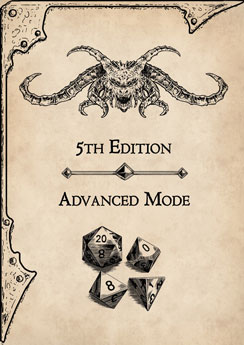Small beast (giant animal), unaligned
Armor Class 15 (Natural Armor)
Hit Points 9 (2d6 + 2)
Speed 40 ft., burrow 5 ft.
Proficiency Bonus +2
Proficiency Bonus +2 (5th Edition Advanced Mode)
| STR | DEX | CON | INT | WIS | CHA |
|---|---|---|---|---|---|
| 14 (+2) | 13 (+1) | 13 (+1) | 1 (-5) | 8 (-1) | 1 (-5) |
Skills Perception +1
Weknesses Cold, Fire
Senses tremorsense 60 ft., passive Perception 9
Languages Pherormones
Challenge 1/8 (25 XP)
ACTIONS
- Bite. Melee Weapon Attack: +4 to hit, reach 5 ft., one target. Hit: 5 (1d6 + 2) piercing damage.
5th Edition Advanced Mode
Limiting the power of a character and making the overall difficulty of the game harder, does not reduce the creativity, indeed it does quite the opposite.
The Game Master has the option to use any and all of the instances proposed in this guide, or just some of them according to their preference.
It is the lack of something that move and motivate characters, not the abundance of it
DESCRIPTION
Giant ants are enormous versions of their normal-sized cousins, with a segmented body, six legs, and powerful mandibles. They come in different varieties, such as workers, soldiers, and queens. Workers are the most common type of giant ant, and they are responsible for gathering food, building and maintaining the nest, and caring for the eggs and larvae.
COMBAT
Giant ant workers are not very aggressive, and will usually avoid combat unless provoked or defending their nest. However, if they do attack, they can inflict serious damage with their mandibles, which can crush bones and armor with ease. Some workers also have a stinger at the end of their abdomen, which can inject a paralyzing venom into their enemies. Giant ant workers are very loyal to their colony, and will fight to the death to protect it. They can communicate with each other using pheromones, which allow them to coordinate their actions and alert others of danger.
HABITAT/ ECOLOGY
Giant ant workers live in large underground colonies, which can house thousands of individuals. The colony is ruled by a single queen, who lays all the eggs and is the only fertile female. The queen is guarded by soldiers, who are larger and stronger than workers, and have more prominent mandibles and stingers. The workers serve the queen and the colony by performing various tasks, such as digging tunnels, collecting food, feeding the larvae, and cleaning the nest. Giant ant workers are very industrious and cooperative, and will sacrifice themselves for the greater good of the colony.
ECOLOGY
Giant ant workers are omnivorous scavengers, who will eat almost anything they can find, such as plants, fungi, carrion, or smaller creatures. They can also hunt larger prey in groups, using their numbers and venom to overwhelm them. Giant ant workers store their food in special chambers within the nest, where they also deposit their waste. Giant ant workers are an important part of the ecosystem, as they help recycle organic matter and aerate the soil. However, they can also be a nuisance or a threat to other creatures, especially if they invade their territory or compete for resources.
